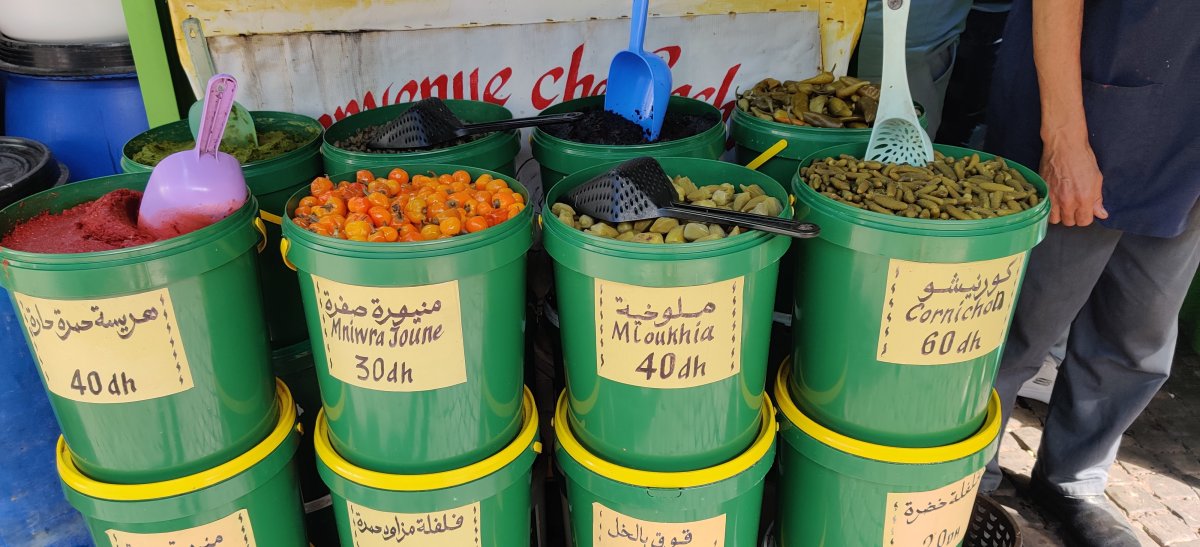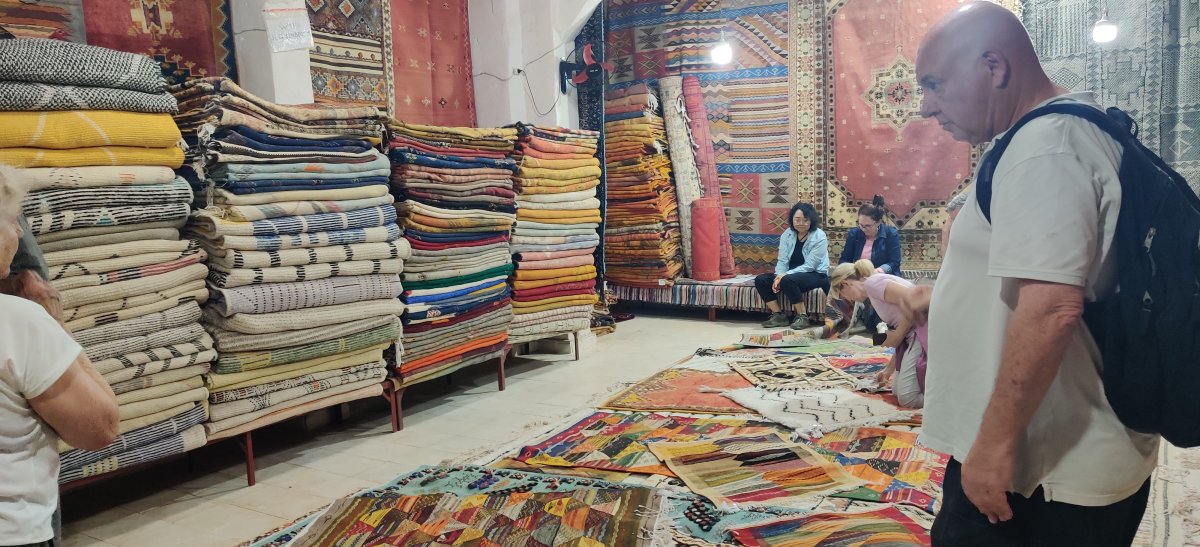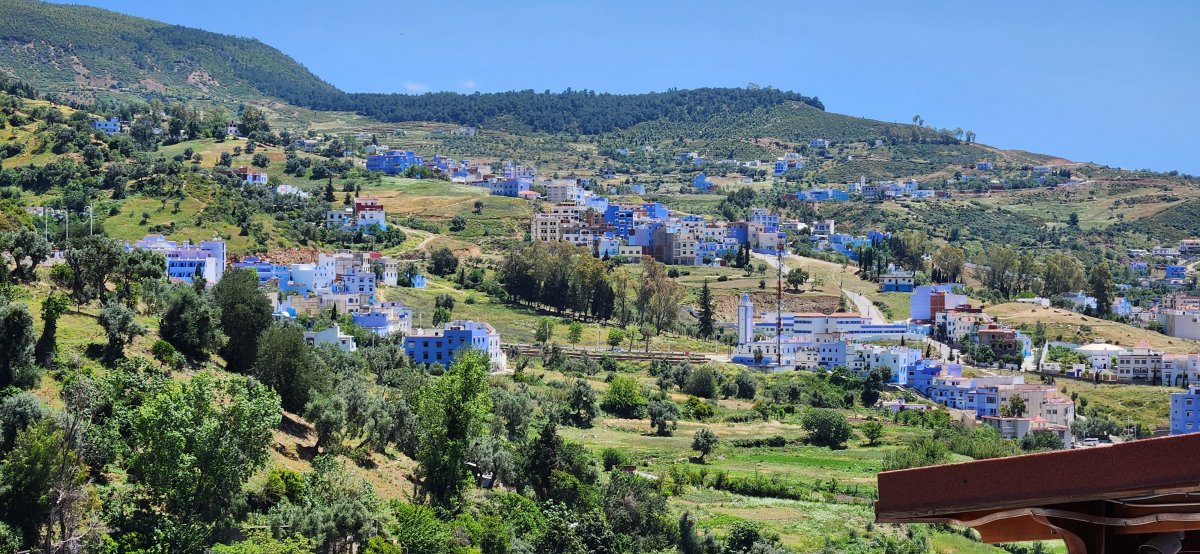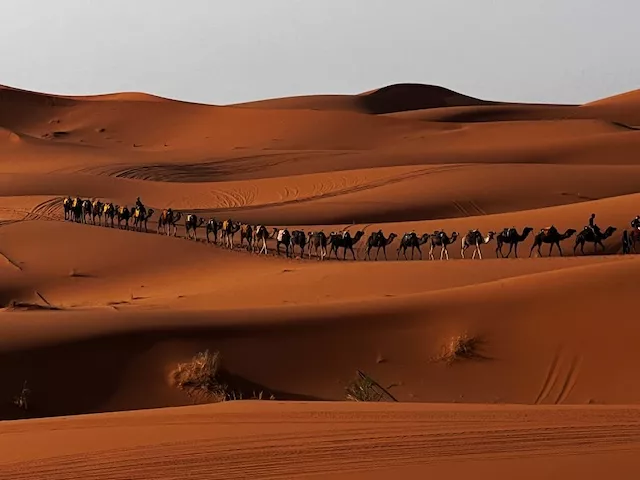May 29, 2024
From May 5 – 19, 2024, the Sierra Club Angeles Chapter and Crescenta Valley Group completed a 1400-mile bus trek through Morrocco. Leaving no stone unturned, we visited 7 UNESCO world heritage sights and climates ranging from the hot dry Sahara dessert to the cooler windy high Atlas Mountains and breezy Mediterranean seaside. In some areas we saw fig trees and bitter Seville oranges, Jacaranda, rosemary, nasturtiums, dates, and almond trees, like we have in California.

Photo by Sima Patel
Accommodations
We stayed in a variety of hotels and *riads with one night tent glamping in the desert. Hotels in Marrakech, Essaouira, Dades Gorge and Chefchaouen had pools, as did the beautiful Riad Maktoub in Ait Ben Haddou. The Swiss alp like Le Palais de Cerisiers in Azrou had great views and pools but one was under construction and the other was closed for the evening. While some of the hotels had had seen better days, with small rooms, leaky showers, and minimal lighting, all were clean and comfortable. The Xaluca Dades in Dades Gorge and the Atlas Essaouira were decadent and upscale, with the Atlas located across from the ocean! One member of our group mused that the nicer the hotels the less time we spent in them, usually only one night.
*The term "riad" is nowadays often used in Morocco to refer to a hotel or guesthouse-style accommodation with shared common areas and private rooms, often within a restored traditional mansion.
Our Guide
Our knowledgeable guide, Sa’id could have been an Imam in another life. He patiently taught us Moroccan Arabic phrases like “Yalla” (Let’s go) and “Shukran” (Thank you), sometimes singing greetings to us, like a canter in the Jewish tradition. We learned about Morrocco through his lens: a 29-year-old bearded, braces-wearing, mountain climbing father of two small children. His bright smile and frequent, “Sounds good?” kept our spirits up through long sometimes arduous days visiting several towns and sites along the way but always with a pause for Moroccan sweet mint tea and the “happy room,” (toilet).
Sa’id patiently attended to older group members, checking in and assisting when a hike or walking tour was too taxing. Our group included many participants in their 70s and 80s, and 4 women celebrating their 60th birthdays in 2024, the Year of the Dragon.
Food
Morrocco has a diverse array of popular dishes. We were mostly served chicken tagine with preserved lemon and olives, bland cous cous with vegetables and flavorful meat tagines, sometimes with prunes. Many participants enjoyed the ‘taco sandwiches’ at lunch, a sort of flavorful French fry turkey or chicken wrap. There was also pizza and the Berber omelet with a tomato sauce. Many Moroccans eat a larger lunch. Ours included salad starters (roasted eggplant and peppers, grated carrots, and beets), a main tagine and desert of fruit, yogurt, or flan. Moroccan has terrific sweets made with almonds, raisins, pistachios, and dates. In the desert region, we enjoyed a box of Moroccan medjool dates.

Photo by Sima Patel
One of our best dining experiences was a lunch in the Fez (they write it Fes) medina at Restaurant Les Mystres de Dar Tajine. This family run operation purchased their produce fresh from the morning market creating an elevated experience. We enjoyed meze type salads: lentils, cauliflower, eggplant, fava beans, and the ubiquitous spicy green and salty black olives. It was here that we had our first taste of pastilla, a gorgeous chicken pie laced with onions, saffron, sugar and almonds folded into filo dough.
Breakfasts were included on the trip and often featured those same olives along with Moroccan, fried pancakes, baked semolina ‘scones,’ raisin or almond croissant, cucumbers, tomatoes, yogurt, hard boiled eggs or omelets and a hot cereal made with semolina, garlic, onions and zaatar (a type of oregano) garnished with olive oil.
Sampling dates, olives, walnuts, almonds, peanuts, and raisins at the medina stalls was tantalizing. So many varieties; all so fresh! We saw ras el hanout (earthy mix of eight spices) in its whole and powdered forms, along with mountains of olives, mint, and parsley. In Chefchaouen, women were selling goat milk, olive oil, lettuces, carrots, beets, mint, sorrel, and fava beans along the narrow paths of the blue medina, the local ‘farmer’s market.’

Photo by Sima Patel
Many participants enjoyed drinking hot sweet mint tea (Moroccans say they enjoy tea with their sugar) several times a day, in the morning, at rest stops and sometimes in the early evening when we arrived at a hotel or Riad. Even in the cities and hotels crowded with tourists, Moroccan hospitality was warm and welcoming.
Four members of the group enjoyed their own farewell dinner at Rick’s Café, which tries to create the same ambiance and food from the film, Casablanca. The place is beautifully lit and authentically designed with the famous piano. You can imagine Bergman and Bogart sitting together at a table. We enjoyed a French 75 and martini from the film along with steak, fish, pasta, and fig goat cheese salad albite at American prices. Rick’s requires a reservation and has a dress code: no cargo pants, flip flops or sneakers.
Bathroom Etiquette
In Morrocco, toilet paper in discarded in the basket beside the toilet and the bathroom attendant is given a few cents. We carried toilet paper with us in case it was not available. Traditionally, Moroccans (and many other African countries) use water and their left hand after using the toilet. Some toilets had a seat while others were French style, a hole with two-foot ledges from which to squat.
Muslim Light, Prayer Ablutions and Jews
Often called Muslim “light” because drinking is tolerated and not all women cover their hair, most Moroccans still practice their faith praying five times a day after conducting their ablutions which includes washing their head, eyes, nose, face, mouth, hands to the elbow and feet in preparation for each prayer. The first call to prayer is heard before 5:00 am and the last shortly before 10:00 pm. A live person not a recording calls in the faithful.
We were frequently reminded that Morrocco has a history of tolerance toward other cultures and religions. While touring medinas, we visited several Jewish quarters, known as “Mellah’s,” along with a synagogue in Marrakech but did not meet any Jewish Moroccans. Some of these areas appeared run down, still showing visible damage from last year’s earthquake. It appears most of Morrocco’s Sephardic Jews have emigrated elsewhere.
Wine and Smoking
Morrocco produces some excellent wines especially in the Meknes region but the tour did not include wine tasting. Nonetheless, some participants purchased wine at the local high-end supermarket, Carrefour. Great Moroccan red, white and rose could be procured for $7- $10. There were also some wine stores, which closed by 8:00 pm.
Curiously, when served wine in a fancy restaurant in Casablanca, a mandatory salad came with it, perhaps to forestall the effects of alcohol? Unfortunately, smoking is still allowed inside restaurants and bars in Morocco.
Money, Phones, Internet, and Taxis
It was challenging to procure Moroccan dirhams before embarking on the trip so we used an ATM machine once we arrived. We were encouraged to bring dollars: pristine one-hundred-dollar bills to change and one and five dollar bills to leave as tips. Upon arrival in Marrakech, I paid $16 dollars or 160 dirhams for a taxi to the hotel. Most participants were picked up from the airport. Moroccans prefer payment in dirhams so we tried to keep cash on hand, especially small bills and coins. For example, a petit taxi ride in Marrakech cost 30 to 50 dirham ($3 - $5 dollars). The price was higher at night. Tips of 10 – 20 dirhams ($1 - $2 dollars) for hotel housekeepers or bathroom attendants were appreciated.
Since their economy is heavily dependent on tourism, Moroccans suffered during Covid. The 2023 earthquake did not help either. They are very happy to have tourists back and we saw busloads, from Italy, Bulgaria, and China.
Along with Spain and Portugal, Morroco is hosting the World Cup in 2030 (after North America in 2026). They are already planning for this major event since football is extremely popular. Men were often watching soccer matches whether from their medina stall or café television.
Phone service and internet works well all over Morrocco, even in the Sahara Desert! Our guide spent some of his camel ride conversing on his cell phone even though we seemed far from civilization and cell towers.
Shopping and Bargaining
Many participants on the trip enjoyed shopping. When asking our guides how much something cost it was difficult to get a straight answer. They would sometimes reply, “it depends,” because negotiating or bargaining is the norm in Morrocco. You pay what you think something is worth. Having practiced bargaining during my years in the Peace Corps, I enjoyed the banter and humor with local shop keepers. Throughout the tour, we were directed to tourist cooperatives or shops that maintained American prices, but when visiting the less touristy medinas of Azrou, Meknesh, and Casablanca, prices were more reasonable. Generally, the best strategy is to ask the price for an item, then offer half and negotiate to an agreeable middle ground.

Photo by Sima Patel
Moroccan Society
Moroccan society is stratified between very poor and very rich with a small middle class. Many men maintain jobs outside the home while women are expected to cook, clean, wash clothes, raise children, and manage everything inside the home. For example, our guide, Sa’id appeared to be middle class and had been educated as a tour guide. He spoke English very well and enjoyed mountain climbing. He told us his wife dropped out of secondary school and was content at home in Marrakech raising their two small children, ages two and five. Sa’id also said women would be uncomfortable sitting in cafés sipping tea as is common in every city. Several of our women participants raised their eyebrows at such assertions. We loved Sa’id but he was not a feminist.
We saw women with heads uncovered strolling and sitting in cafes in Casablanca and women smoking in Marrakech! And, at breakfast at the Hotel Rihab in Rabat, we rubbed shoulders with the Moroccan National Pétanque team, third in the world, including many women players!
Monkeys, Cats and Dogs

Almost on cue, as we drove through the Cedar Forest, the Barbary Macaques monkeys came out to greet us, including a mother and her newborn. The wild monkeys enjoyed eating peanuts from our bus driver and put on a show, getting close enough to snatch a bag of goodies out of one person’s hands.
Moroccans love their cats! Many participants enjoyed petting and feeding them. There were cats in every town, often with a litter of kittens. Dogs on the other hand seemed less popular. A green tag on the ear meant they were spade and had shots. Several nights sleep was interrupted by dogs barking. Earplugs were essential on this trip. Air conditioners also helped.
Photo by Sima Patel
Best Experiences
Perhaps our most memorable trip experiences were camel trekking to a Sahara Desert oasis and two nights spent in the mountain town of Chefchaouen.
Riding a camel is not easy on the groin and you really must hold on when the camel stands up to avoid falling off. I found riding side saddle like the locals much more comfortable. We were led by young and entertaining Amzigh (the name Berber tribesmen prefer to be called). Once we reached the camp, we enjoyed music from a local Gnwah musical group over dinner. Glamping in our hot desert tents was challenging but we were able to shower and plug in our phones, then awaken to the incredible colors of a Sahara sunrise!
The blue city of Chefchaouen was a favorite stop for many participants. It featured friendly welcoming locals, an alluring medina in a color palate of blues, and surrounding alps-style mountains and waterfalls. This town was a keeper. We stayed at the Hotel Parador, a basic hotel with a pool and the perfect location to view the Spanish Mosque and explore the narrow blue pathways of the medina with great restaurants and shops all within walking distance. A local hike was offered and many participants enjoyed a day shopping and interacting with locals. The hotel was situated high up on a hillside with a spectacular view of the city and Spanish Mosque.
 Chefchaouen, also known as the Blue City, is located in the Rif Mountains of northwest Morocco.
Chefchaouen, also known as the Blue City, is located in the Rif Mountains of northwest Morocco. The city is situated in the foothills of the Kaʻala mountain, about 2,000 ft above sea level, and about two hours south of Tangier
We enjoyed a memorable two weeks in the northern tip of Africa, submersed in a completely different culture. Thanks to Fred Dong, Stephanie Gross, and Sridhar Gullapalli for organizing and leading our brilliant odyssey through Morocco!
